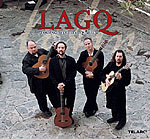
LAGQ Latin
CUBA
Cuban Eduardo Martín shows up twice in this collection, in the virtuosic La Trampa (The Trap), featuring a rhythmic drive not too far removed from the feel of Santana's Black Magic Woman, and in Hasta Alicia Baila (Even Alicia Dances), based on the guaguancó, a "call and response" form of the Cuban rumba. Fans of the Buena Vista Social Club will feel quite at home with the spirit of Hasta Alicia Baila. Cuban Landscape with Rain by pre-eminent Cuban composer Leo Brouwer is a descriptive piece no less itemized in its detail than the most evocative tone poem by Richard Strauss. From the first occasional water droplet to a raging torrent replete with a brief hail storm toward its end, this is meticulously programmatic music.
CENTRAL AMERICA
From Mexico, by way of Brooklyn, come two of the three Latin-American Sketches by American Aaron Copland who, as evidenced by El Salon Mexico and the Cuban Dance, was undeniably drawn to music south (and far south) of the border. The poetic and lyrical Paisaje Mexicano (Mexican Landscape) and the bouncy Danza de Jalisco (Dance from Jalisco) were written as a pair, some dozen years before the third sketch. Copland wrote "The tunes, the rhythms and temperament of the pieces are folksy. . . .the music sizzles along." During the recording sessions for this album, producer Bob Woods suggested that LAGQ include Sting's Latin-tinged song Fragile, written in response to the death of a friend in Nicaragua in 1987. (During the post-9/11 concert "America: A Tribute to Heros" Sting offered a heartfelt rendition of the song). Fragile is performed here in the group's haunting instrumental arrangement. The atmospheric percussion accompaniment is provided by Tim Timmermans.
SOUTH AMERICA
The soul of contemporary Brazil is captured in a reworking of Forrobodó by jazz great Egberto Gismonti, who writes that the forro "is synonymous with confusion. Forro is a music from northeastern Brazil. . . .Forro means to party, to dance." Argentinian-born tango master Astor Piazzolla, though born in South America, was a citizen of the world (having studied in France and lived in America and Italy). Piazzolla elevated to high art the dance form known as the tango which, like the blues and flamenco, developed as a way to give voice to a downtrodden social group. Piazzolla is here represented with an arrangement of Fuga y Misterio (Fugue and Mystery).
SPAIN
Andrew York of LAGQ provides us with an "arrangement-plus" of the famed slow movement from Joaquin Rodrigo's most popular work, the Concierto de Aranjuez. York's Aires de Aranjuez (Breezes of Aranjuez) was inspired by an out-of-doors performance of the Concierto the group heard played at the 2001 Rodrigo Centenary Celebration at Aranjuez Castle in Spain. York's "rethinking" of this music seeks to recreate his memory of that night, when a gentle breeze seemed to be wafting Rodrigo's notes throughout the castle courtyard. The piece begins with the guitars invoking the random sound of wind chimes, a sound mirrored later by the use of the asymmetrical meter of 5/4. In other words, don't try snapping your fingers to this one. You could hurt yourself. York wrote Syzygy as a commission for the San Francisco-based group Festival of Four. This new arrangement of the flamenco-flavored piece features guest artist flutist James Walker. In case your knowledge of celestial events is a bit rusty, when two astronomical bodies are aligned with our Sun so that the three form a straight line, this is called syzygy. At full moon and new moon, the Earth and Moon are at syzygy. At times York's Syzygy sounds distinctly middle-eastern, alluding to the strong Moorish influence on Spanish music. The album's sole duo, played on authentic flamenco instruments by Scott Tennant and John Dearman, is a traditional Sevillanas. The rhythmic clapping "palmas" toward its end, an effect absolutely essential to flamenco, is provided by two fine clappists, Matt Greif (Mateo) and LAGQ's own William Kanengiser (Memo). The other Spanish-inspired music, Kanengiser's arrangement of a suite from Parisian George Bizet's opera Carmen, proves yet again that, like fellow Frenchman Chabrier in España, Briton Elgar in Spanish Lady and Russian Rimsky-Korsakov in Capriccio Espagnol, no one can capture the essence of Spanish culture quite like a complete foreigner. The six-movement suite from Bizet's score is a perennial audience favorite at LAGQ concerts.
- Rich Capparela, El Pueblo del Rio de Nuestra Señora la Reina de Los Angeles de Porciuncula - 2002
| Cardiff Studios Home Page |